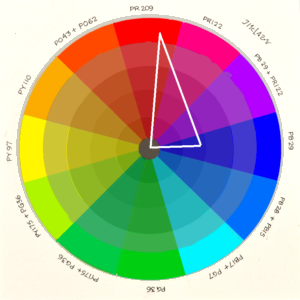The left side of the table below lists a variety of techniques for preserving and recoving light. Across the chart lists different stages of drying: Before you start painting, While the paint is drying (3 sub-stages – Flow, Gloss, and Dull), and After the paint is totally dry. If a technique is applicable for a particular drying stage, there will be a footnote in that column. Refer to the footnotes for detailed information about how to use the technique during that stage.
1. RESIST. Be sure to read the general notes on Using Resist, and be sure to test your resist with the paper you will be using to insure its removal doesn’t negatively affect the paper surface. (I have found that Arches CP has the best performance with Resist).
1a. Before painting Determine where you want to protect your whites/brights – use a pencil (2B is good) to lightly outline the areas where you will be applying resist. Apply the resist along the lines with a tool like an Embossing Stylus (or a Ruling Pen), then fill in the area with an appropriately sized Rubber Brush. Do not try to spread resist once it is on the paper. Use a dabbing technique rather than a ‘brushing’ technique – you want your resist to be rather thick. Avoid applying fresh resist to partially-dried resist – let it “1a”dry completely first. You can also use a nice thick line of resist as a ‘dam’ to help prevent paint from moving to the areas of the paper you want to protect. Now you can apply a nice juicy complex wash without worrying about ‘staying within the lines’.
1b. In Flow State If the paint is still in the FLOW state, your resist will be diluted throughout the wet area. Tilting and using gravity will further distribute (and dilute) the resist. Depending on how much resist you have used, the entire wet area will now have resist on it. At first this might seem like a good way to cover an area. However, when Resist is diluted too much, it becomes very difficult to remove. About a 1:1 ratio with water is the limit if you want to get all the resist off. Progressively more water will make it harder to get off once it dries, and it will be more destructive to the paper surface. This could be an effect you might like.
1c. In Gloss State If resist is added during the GLOSS state, it will disperse somewhat, and when dried and removed it will produce an area that has the paint mostly removed, but the edges will not be as sharply defined as when the resist is applied to dry paper. This can provide some unique effects and textures.
1d. In Dull State Applying resist once the paint is in the dull state will leave a ‘hole’ in the paint, but the resist will not spread significantly
2a. Applied before wetting paper. Tape can be cut to particular shapes and used like a stencil. Narrower tape can be shaped into curves. Try tearing tape for a more interesting and textured edge.
2b. Over dry paint. Tape can be used over dry paint to create a masked area for lifting paint, just like using a stencil.
3. Stencils. Stencils are an excellent way to add texture and patterns to your watercolor. There are incredible varieties of stencils available, or you can make your own by hand or with a home cutter (like a Cricut). I use acetate or mylar for my homemade stencils.
3a. When used on dry paper before the paint is applied, the same rules apply as for tape (Note #4). Make sure the stencil is stuck down good if you want clean edges. If the stencil is non-adhesive, spraying the paint (or resist, etc.) on is the best choice, as brushing will tend to push the paint under the edges of the stencil. Also, with non-adhesive stencils, be sure to remove the stencil as soon as possible.
3b. Applied when paint is wet (GLOSS or DULL state). Just lay your stencil down in the wet paint and leave it until the paint dries for the best effect. Different paints will respond differently, some edging very distinctly, others will pool more.
3c. After paint is dry: Just place the stencil where you want it and lightly moisten the area you want to lift, dabbing up any excess water immediately. Lightly wet a ‘Magic Eraser’ and wipe over the stencil, lifting the paint. Immediately remove the stencil unless you want the edges to become rough. You will now have a damp, lightened area the shape of the stencil opening. You can add pigment to this area if you want and it will stay within the shape.
